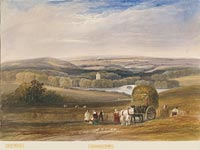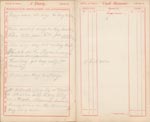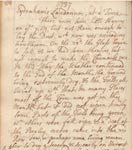
July
July was the traditional month for haymaking and this means that
many of the available archive sources, which comment on the weather,
link it directly to this activity. Rain delayed haymaking and in
some cases ruined hay crops. The financial cost to a farmer of
losing his hay as a result of rain could be considerable. There are
examples of very wet Julys in the county. In 1888, 1923 and 1930
over five inches of rain fell in the month. In 1930 it was noted
that continual rain fell in parts of the county for 24 hours on 20
July.
Formal weather records from the late 19th and early 20th centuries
show that July could also be a month with really hot spells, with
temperatures recorded in the 80s Fahrenheit. Particularly warm Julys
in Staffordshire included the years 1911, when the temperatures went
up into the 90s Fahrenheit, 1925, 1929, 1933 and 1959. On the other
hand there could be much cooler spells. In 1888 and 1930 for
example, lows of 53° Fahrenheit were recorded in the month.
July was also as prone to thunderstorms as June. 1914 was a
year in which ‘tremendous’ and damaging thunderstorms were recorded
at Weston Park in the west of the county.
The extracts are arranged chronologically by the day to show the
progression of weather through the month.
![]() Drought Breaks
at Teddesley, 1 July 1844
Drought Breaks
at Teddesley, 1 July 1844
![]() Intense Heat
Hits Walsall, 3-24 July 1921
Intense Heat
Hits Walsall, 3-24 July 1921
![]() Thunderstorm Provokes Terror in Wombourne, 5 July 1640
Thunderstorm Provokes Terror in Wombourne, 5 July 1640
![]() Rain Stops Play
at Burton, 8-16 July 1908
Rain Stops Play
at Burton, 8-16 July 1908
![]() Fine Weather for Haymaking at Hanchurch, 12 – 14 July 1827
Fine Weather for Haymaking at Hanchurch, 12 – 14 July 1827
![]() Flash
Floods in and around Stafford, 14 July 1852
Flash
Floods in and around Stafford, 14 July 1852
![]() Poor
Haymaking Weather at Longnor, 15 July 1909
Poor
Haymaking Weather at Longnor, 15 July 1909
![]() Reservoir
Level Down at Rudyard, 18 July 1915
Reservoir
Level Down at Rudyard, 18 July 1915
![]() Perfect Weather for Land Army Girls’ Treat at Milford, 20 July 1941
Perfect Weather for Land Army Girls’ Treat at Milford, 20 July 1941
![]() Rain Delays Haymaking at Weston Coyney, 20-26 July, 1840
Rain Delays Haymaking at Weston Coyney, 20-26 July, 1840
![]() A Hot
Tennis Party at Bridgetown, 22 July 1916
A Hot
Tennis Party at Bridgetown, 22 July 1916
![]() Whirlwind at
Barlaston, 23 July 1856
Whirlwind at
Barlaston, 23 July 1856
![]() Fields Burnt up with Heat in South Staffordshire, 1737
Fields Burnt up with Heat in South Staffordshire, 1737
![]() Floods
Destroy Hay Crops at Alrewas, 1878-1880
Floods
Destroy Hay Crops at Alrewas, 1878-1880
![]() A Deep Depression in July in the Staffordshire Moorlands, July 1879
A Deep Depression in July in the Staffordshire Moorlands, July 1879
Drought Breaks at Teddesley, 1 July 1844
From the Diaries of Lord Hatherton of Teddesley
Park, near Penkridge
On 1 June 1840, Lord Hatherton recorded in his diary that there had
been no rain for two months. He went on to record heavy rain
on 25 June, the first since mid March.
1 July- Mr Bright, my Agent, writes me word that a shower had fallen
on Teddesley on Saturday which had penetrated an inch. But it was
not possible to produce much effect- so dry was the surface of the
ground.
5 July- A letter from Bright tells me of a soaking rain- the first
that has fallen for 15 weeks.
Reference: Staffordshire Record Office D 260/M/F/5/26/30
By courtesy of Mr ARW Littleton
© Staffordshire and Stoke on Trent Archive Service
Intense Heat Hits Walsall, 3-24 July 1921
 From the Service Register of St Peter’s Church,
Walsall
From the Service Register of St Peter’s Church,
Walsall
3 July 1921- 6th Sunday after Trinity
Extremely hot weather all through this week
10 July 1921 - 7th Sunday after Trinity
Intense heat continues. This day the hottest recorded in July for 50
years
17 July 1921- 8th Sunday after Trinity
The intense heat still continues
24 July 1921- 9th Sunday after Trinity
Another very hot Sunday
Reference: Staffordshire Record Office D 6876
By courtesy of the Vicar and PCC of Walsall St Peter
© Staffordshire and Stoke on Trent Archive Service
Thunderstorm Provokes Terror in Wombourne, 5 July 1640
 From the Parish Register of Wombourne
From the Parish Register of Wombourne
Memorandum that on July the 5th 1640 being Sunday ther hapned to be
a terrible storme of thundering and Lightning and by some bolt some
stones were struck out of the steeple, the Belfrye windowe was much
broaken and great shaking in the Church to the terror and great
amazement of the people and by reason of the abundance of raine
falling, all our Mill dames were broaken, and all the grasse of the
Meadowes ready to mowe was all spoiled, and the high waye about our
Towne much mared and gored to our great Losse and hindrance.
Reference: Staffordshire Record Office D 3710/1/1
By courtesy of the Vicar and PCC of Wombourne
© Staffordshire and Stoke on Trent Archive Service
Rain Stops Play at Burton, 8-16 July 1908
From the Programme of Burton Cricket Club
|
Date |
Day |
Club |
Ground |
|
July 8 |
Wed- Off |
Ashbourne |
Burton- Wet |
|
July 16 |
Thurs- Off |
Notts Ramblers |
Burton- Rain |
Reference: Lichfield Record Office D 442/4/1/11-25
© Staffordshire and Stoke on Trent Archive Service
Fine Weather for Haymaking at Hanchurch, 12 – 14 July 1827
 |
|
Haymaking at Greenway Bank, North Staffordshire |
12 July- A fine day, busy amongst the Hay in Castle field and carried the whole in fine condition
13 July- Very fine day busy with Hanchurch meadow hay, carried a little of it began to Cut into a rick of New hay being rather warm
14 July- A fine day busy amongst the Hay in Hanchurch Meadow carried a few loads of it in fine condition
Reference: Staffordshire Record Office D593/L/2/2/b
© Staffordshire and Stoke on Trent Archive Service
Flash Floods in and around Stafford, 14 July 1852
 From the Memorandum Book of the Reverend Edward
Harland, Vicar of Colwich
From the Memorandum Book of the Reverend Edward
Harland, Vicar of Colwich
For the last week the heat of the weather has been remarkable, the
thermometer having frequently stood at 90 in the shade, and several
persons having been killed in London, Paris and elsewhere by a coup
de soleil. On the evening of this day a tremendous storm of thunder
and lightening accompanied by immense torrents of rain occurred in
this neighbourhood. Its chief fury was spent near Stafford where a
cow and a horse were killed & in a few minutes the main street & the
houses in it (and amongst the rest the Rectory) were a foot deep in
water, and so continued for above an hour before the flood could
escape. At Haughton the garden Wall at the Rectory was washed down &
the house & garden flooded. At Acton Hill in the Parish of Berkswich
15 sheep, & at Stone 4 sheep were killed by the lightning. A great
oak tree near Sandon Church & a Great oak near the Nunnery at
Colwich were struck down & much other injury done in other places.
Reference: Staffordshire Record Office D874/2/27
© Staffordshire and Stoke on Trent Archive Service
Poor Haymaking Weather at Longnor, 15 July 1909
A threating [threatening] day Rained a Little at
Intervals until Night then commenced in earnest…. Very poor Hay
Weather
Reference: Staffordshire Record Office D6794
© Staffordshire and Stoke on Trent Archive Service
Reservoir Level Down at Rudyard, 18 July 1915
From the Weekly Reports of the State of the
Reservoir
Rudyard Lake was built in 1797 as a reservoir to support the growing
canal network in North Staffordshire. As well as the state of the
reservoir itself, this record gives daily information about the
weather.
North Staffordshire Railway Company
Weekly Report of the State of the Reservoir
Under level 6am- 2 feet
Under level 6pm – 2 feet
Paddles open day – 0
No of paddles open- 0
Commenced water running- nil
Paddles open night -0
No of paddles open -1
Stopped water running- nil
Rain gauge – 18 inches
Thermometer highest 52
Thermometer lowest 50
Weather – fair
Other remarks- increase 7 inches
Reference: Staffordshire Record Office 6783/1/6
© Staffordshire and Stoke on Trent Archive Service
Perfect Weather for Land Army Girls’ Treat at Milford, 20 July 1941
From a circular letter to Women’s Land Army Girls
from Cicily Frith, the County President of the Women’s Land Army
On July 20th Mrs Haszard had prepared a wonderful spread of
sandwiches, cakes, fruit drinks etc at her lovely house, Milford
Hall, for the girls in the Stafford area. It was a perfect day, but,
unfortunately, only seven of eight girls were able to come and enjoy
the good things, treasure hunt, bowling etc prepared for them. Those
who were present enjoyed every minute of it and only wished more
could have been present.
Reference: Staffordshire Record Office D1001
© Staffordshire and Stoke on Trent Archive Service
Rain Delays Haymaking at Weston Coyney, 20-26 July, 1840
 From
the Diary of Jacob Marsh, Farmer, of Lane End
From
the Diary of Jacob Marsh, Farmer, of Lane End
20 June – Heavy rain all day, no Haymaking
21 July- rain most of day, no Haymaking. Rec[eive]d a letter from MM
from Rotterdam.
22 July- Fine day dry but no haymaking. Went to see the Steam
carriages, much surprised.
23 July- Fine day, got hay ready for carring [carrying or possibly
carting]
24 July- Rain no Hay Making
25 July- Mr Holbrook & family return’d to Alvaston with Betsey Riley
on a Visit, Showers
26 July- Heavy rain in the morning. Hay very wet.
Reference: SD 1465
© Staffordshire and Stoke on Trent Archive Service
A Hot Tennis Party at Bridgetown, 22 July 1916
From the Diary of Mrs Elizabeth Hagar Whitehouse
The following extract suggests a very hot day. A formal weather
record from the county for this date records a temperature of 79°
Fahrenheit.
22 July Sunshine
We had tennis party in the afternoon. Kathleen Miss Fisher, Hilda
Mabel Ros Mr & Mrs Fairley Lieut Nicholls. Had a good time & plenty
of tennis but O it was warm. Much nicer after tea.
Reference: Staffordshire Record Office 6788/1
© Staffordshire and Stoke on Trent Archive Service
Whirlwind at Barlaston, 23 July 1856
From The Staffordshire Advertiser
A correspondent furnishes us an account of a whirlwind which caused
much damage between Parkfields and the Barlaston station on
Wednesday 23 [July], the same day on which a thunderstorm passed
over the Potteries It is remarkable that the same wind which brought
the thunder and sever hailstorms was form the NW, while the
whirlwind came about the same time (half past four o’clock in the
afternoon from the SW or SSW and passed across the valley of the
Trent to the east of Parkfields, west of Barlaston station and out
in the direction of Barlaston hall, doing much damage among the
trees and hay the whirlwind from its ravages, has been traced for
about two miles in length and from fifty to a hundred yards in
breadth. Trees were deprived of their branches nearly along the
whole course taken by the whirlwind and the hay was much scattered,
the latter in some instances being carried to a great height in the
air. On the road between Parkfields and Barlaston station the most
violent ravages of the storm are seen. Several of the oak trees have
lost their largest limbs, and some are completely dismantled, though
other trees not ten yards distant have not lost a branch……. The
storm lasted from five to eight minutes and was accompanied by a
rushing noise. There was no rain at the night. The barometer which
stood at 29.45 in the morning had fallen to 29.35 an hour after the
occurrence, The thermometer stood at 68°.
Reference: William Salt Library, Staffordshire Advertiser, 16
February 1946
By courtesy of the Staffordshire Newsletter
Fields Burnt up with Heat in South Staffordshire, 1737
 From the Diary of Dr Richard Wilkes of Willenhall
From the Diary of Dr Richard Wilkes of Willenhall
There were some little showers on the 7,8,9 but not Rain enough to
lay the dust, which was now exceeding troublesome. On the 22nd the
Glass began to fall & we had some showers, but not enough to make
the Channels run. In this Way, the Weather continued to the End of
the Month, the ground being extremely dry and the Fields all burnt
up with Heat. In many Places most of the Corn was got in this Month
but it did not ripen kindly, some Parts of the Field being green,
when others were full ripe & a deal of the Barley came into the red
Row. Few, or perhaps none living remember so dry a season & so early
an Harvest.
Reference: Staffordshire Record Office 5350
© Staffordshire and Stoke on Trent Archive Service
Floods Destroy Hay Crops at Alrewas, 1878-1880
From the Sale and Purchase Account of Manor Farm,
Alrewas
The following extracts show the financial losses which could be
sustained when bad weather hit the hay crops.
1878- Meadows Flooded
The whole spoiled
Loss about £200
1879- Meadows Flooded
The whole spoiled
Loss about £200
7 July 1880
Wednesday Riles[the farm labourer]] commenced mowing in
Meadows at 5/- per acre
Ditto Thursday
Ditto Friday
Ditto Saturday
Flood stoped them
Reference: Staffordshire Record Office 3576/3/6
© Staffordshire and Stoke on Trent Archive Service
A Deep Depression in July in the Staffordshire Moorland, July 1879
 Extract from published observations on the summer
of 1879 in the vicinity of the Staffordshire Moorland and Churnet
Valley.
Extract from published observations on the summer
of 1879 in the vicinity of the Staffordshire Moorland and Churnet
Valley.
This was a particularly unseasonal summer in the north of
Staffordshire.
JULY- Atmospheric Pressure - Highest reading of barometer (at 32 F)
29.425 ; lowest 28.572, 20th; monthly range 0.853
Temperature (shade)- Maximum, 28th, 73.4; minimum, 11th, 43.9;
monthly range 29.5.
Rain from July 1st 9am to August 1st 9am, 4.304 inch or 434½ tons
per acre.
Remarks: July came in with a large and comparatively deep
depression, the barometer falling 0.624 in the space of twelve
hours. This sudden decrease was accompanied by a total rainfall of
1.171 that amount falling in 48 hours) and fresh WSW gales.
Reference: William Salt Library On the summer of 1879 in the
vicinity of the Staffs Moorlands and Churnet Basin by Clement L
Wragge
© William Salt Library